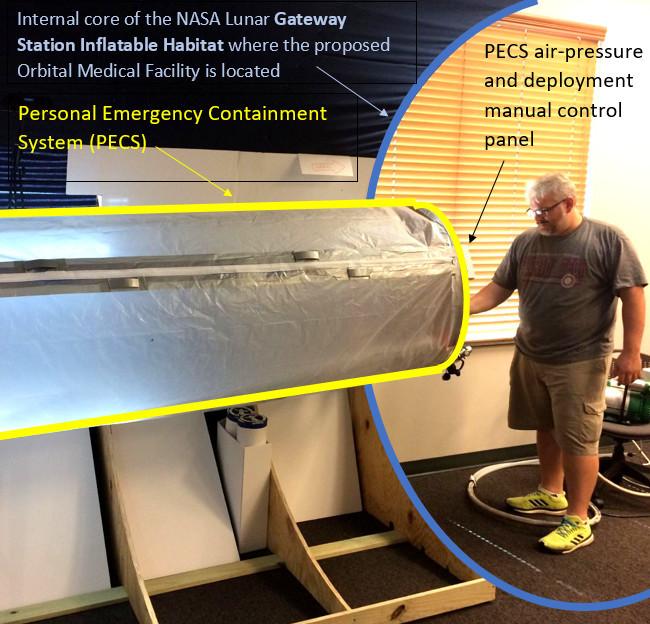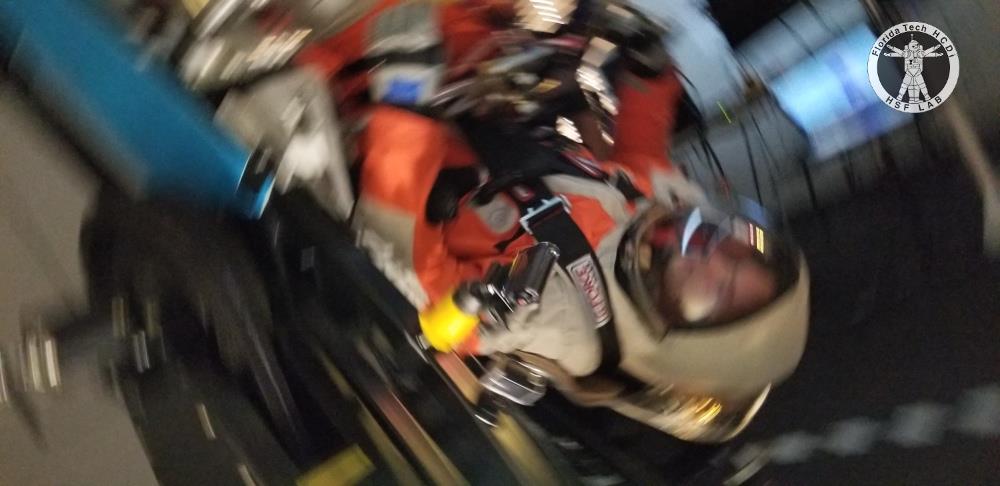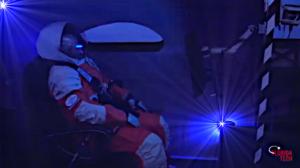HSF Laboratory supports a diverse portfolio of science, engineering, design, policy and management projects. Students can chose the scope and system or engineering, analytical human factors or design oriented approaches based on their career interests. Students can also continue developing projects listed below. Examples of past and running projects are provided:
- Astronaut Personal Emergency Containment System: System architecture and system engineering study that includes Humans In The Loop (HITL) simulation use of IVA spacesuit, deployable systems and concept of a Orbital Medical Facility. (see below for more details)
- ErgoTrack: A multi-phase, continually running project, addressing a need for spatial requirements and function allocation models in extreme environments of human spaceflight. This project divides in two streams, IVA spacesuit operations models and microgravity operations models e.g.: Adjustable IVA Spacesuit Ergonomics for Commercial Space Transportation – Upper Body Motion Envelope Reference Model
- Human Input System for Commercial Spaceflight (FAA COE CST Task 398): Immersive, design research project using HITLS to investigate the most accurate and dependent input systems in variable gravity environment of human spaceflight.
- Mission Architecture to Mars: A parametric, mass-oriented comparative study considering scenarios with different trajectories including a propellant mining station on the Moon as well as Mars Direct mission architectures.
- Omni-directional Radiation Detector and Awareness System: A novel technology research and innovation for a real-time radiation magnitude and direction awareness inside the spacecraft cabin.
- Planetary Analog Launchpad: Space Architecture and Civil Engineering project on sustainability, deployment and operational requirements of the first outpost establishment on another celestial body.
- Streamlined Export Control for Commercial Spaceflight (FAA COE CST Task 402): An investigation into the strategy of the commercial spaceflight environment in academic and industrial settings providing guidance through the export control best practices within a design project life cycle.
- Suborbital Spaceflight And IVA Spacesuit Applicability: A thorough, experience based human factors analysis project to investigate the space tourists' perspective on spaceflight safety and concerns regarding suited or unsuited operations. (see below for more details)
- Spaceship Cockpit Architecture: System design guides for human-system integration in spacecraft cabin or cockpit developed based on experimental evaluation of different human-system interfaces using Humans In The Loop Simulations (HITLS)
- System of System Architecture for Human Spaceflight: Enterprise Architecture Research and Development for modeling and simulation of the Commercial Space Transportation socio-technical environment.
- Gravity Resistant Human Input Interface Platform: Application of guides and frameworks for spaceship cockpit input systems and cabin architecture in form of a input system concept.
- Orbital Station Command and Control Functional Analysis: Human-System Communication, Command and Control analysis and concept for a small cislunar station (e.g., Lunar Gateway).
- Adaptive Spaceship Cockpit Simulator Evolution: 2.5 axis motion base system evolution regarding motion control, control software display interface and physical and cognitive ergonomics in areas of spacesuit interface, life support interface, input systems interface and operational envelopes requirements.
- Multi-mode G-transition Motion Sickness Counter Measure System: Experimental investigation (HITLS) of an optimal strategy for mitigation of astronaut motion sickness and enhance a no-reference orientation in microgravity using pharmaceutical and wearable technology
- One-hand Donning Spacesuit Glove: Research and Development of a One-Hand Rapidly-Donning Pressure Glove locking mechanism component for IVA and EVA spacesuits.
- Analog Platform for Planetary Surface Contamination Research: Human Spaceflight time and resource oriented modeling and simulation of human activities with focus on biological contamination related to prolonged extravehicular activity on planetary surface.
- Human Spaceflight Sea Landing 8-axis Simulator Compound: Motion base simulator combining independent platform for sea state simulator and an occupied space vessel simulator.
Astronaut Personal Emergency Containment System
Keith Crisman, Ondrej Doule
Personal Environmental Containment System (PECS) is an integral component of an Orbital Medical Facility (OMF) concept intended as part of NASAs Lunar Gateway project. The principal investigator, Mr. Crisman (HCD 6999) introduces the project in the following videoclip.
The primary purpose of this system is bidirectional; to either protect an individual from a potentially contaminated environment or to protect the environment from a potentially contaminated individual.
The system displayed below is a 1:1 scale, partially functional prototype prepared for research to investigate its usability and discovery of emergent design requirements through humans-in-the-loop simulation. This prototype is the second iteration and was created through collaboration with subject matter experts as well as humans-in-the-loop simulation and the group elicitation methods.
An ongoing technology integration research is in the area of the main deployable envelope (the habitable volume) its access and entry configuration and interface to the current bulkhead with the manual control board. The system uses commercial off-the-shelf components (COTS) to maximum extent and is complemented through the use of additive manufacturing methods to create components that are not available or are unique to this system. The PECS is designed to meet requirements derived from NASAs Human Spaceflight Standards as well as NASA Human Factors and NASA Human System Integration Handbook.
Published at IAC 2019: Crisman, K., Doule, O., Momose, K. 2019, Cis-Lunar Orbital Medical Facility and Roadmap

Keith Crisman (on the photo), Ph.D. Candidate in Human Centered Design with a background in Human Factors of Aeronautics (M.Sc. FIT) and Psychology/Biology (B.Sc. UND), is the current Health and Safety Officer for the Human Spaceflight Laboratory.
Suborbital Spaceflight And IVA Spacesuit Applicability
Alexandra Coultrup, Ondrej Doule, Rian Mehta, Keith Crisman
A two-phase research on public opinion and applicability of the Intra-Vehicular Activity Spacesuit integrates data from online questionnaires and spaceflight simulation at the Human Spaceflight Laboratory (within AHF 5999). The principal investigator, Ms. Alexandra Coultrup introduces the project in the following videoclip.
The objective of this study is to understand potential passengers’ willingness to participate in commercial suborbital spaceflight and their attitudes regarding safety and comfort. Researchers also seek to understand subjects’ experiences and resulting opinions from
interacting with an IVA spacesuit as a one option of a protective garment.
Public opinion regarding the garment best suited for wear by spacetourists on suborbital vehicles can provide important insight to cockpit and cabin design, training procedures, and overall safety potential of commercial spaceflights.
This multi-phase study seeks to provide an initial data for human-centered design of commercial spaceflight vehicles by examining consumer attitudes toward garments for spaceflight and presenting both quantitative and qualitative analysis of the findings.
The cabin mockup used for the study is a 1:1 scale representation of the interior of a commercial suborbital spaceflight vehicle cabin that incorporates findings from existing research to provide a high-fidelity environment for spaceflight simulation (Doule, 2008). Elements include ergonomic window shape to accommodate field of vision during recumbent posture, seating arrangement chosen for comfort and accessibility, and safety elements including seat restraint. In Phase 1 of the study, a questionnaire measuring attitude toward spaceflight garments was distributed to two distinct audiences: a sample representative of the general United States population, and a sample representing the faculty and staff of Florida Institute of Technology. In Phase 2 of the study, a gender-balanced sample of subjects participated in a spaceflight simulation while wearing a high-fidelity IVA spacesuit suitable for suborbital spaceflight, then responded to the same questionnaire distributed in Phase 1. Phase 2 participants also participated in a qualitative debrief conversation with the lead researcher. The results of this study could provide insights for future research on how to best integrate cabin hardware that accommodates consumer preferences.

 Give to Florida Tech
Give to Florida Tech 
